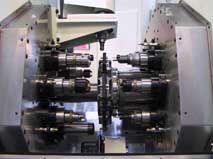Rotary transfer machine
Rotary indexing machines are machine tools, in which the to be machined workpiece in a horizontal or vertical rotary table is clamped or table top.
Tensioning of the workpieces in the table top and timing of the table top
The workpieces can be clamped with one-sided or centric clamping jaws or collets . The indexing table clocks from processing station to processing station, at which the stationary, non-rotating workpieces are processed simultaneously with driven tools ( driven tool ). In the classic lathe , the material or workpiece rotates and the tools are not driven.
Drives of the processing units
The work spindles of rotary transfer machines are driven by electric or servo motors. Almost all common machining processes such as drilling, turning and milling as well as forming processes such as roller burnishing, punching and embossing can be carried out.
Control of the feed of the machining units
The indexing table or indexing table ( turntable ) and the processing units can be driven and controlled in different ways. Originally, the feed of the machining units was controlled mechanically by cam gears. The machine controls introduced in machine tool construction in the 1980s only became so powerful at the end of the 1980s that they could also be used in rotary transfer machines. The CNC controls ( numerical control ) make the rotary transfer machines more flexible and the advantages of rotary transfer machines can also be used for smaller quantities within part families. The curve technology is still used in parallel to the CNC technology. Cam-controlled rotary transfer machines are very fast, but can only be converted to a different workpiece with great expenditure of time.
Use of rotary indexing technology
Rotary transfer machines are mainly used for machining workpieces or families of parts in large numbers. A finished workpiece is removed from the machine with each cycle of the table top. Depending on the machining, up to 60 workpieces per minute can be finished on a rotary transfer machine.
The otherwise difficult-to-achieve tolerances of the combined processing steps are also advantageous, since the workpiece does not have to be re-clamped.

